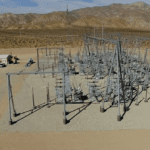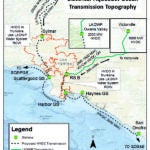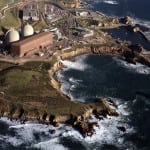Catastrophic wildfires have devastated California in recent years. This article seeks to outline a plan wherein neighboring utilities can send energy to support a utility that has shut down critical paths during wildfire mitigation efforts.
On the morning of Nov. 8, 2018, the Camp Fire erupted 90 miles north of Sacramento, California (Figure 1). This fire was the deadliest and most destructive wildfire in California history, ultimately causing 85 fatalities.
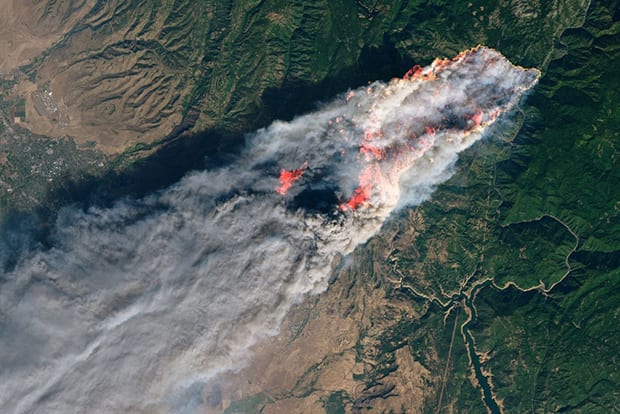 |
| 1. The Camp Fire as seen from the Landsat 8satellite. Source: NASA/Joshua Stevens |
The fire started under Pacific Gas and Electric’s (PG&E’s) 115-kV transmission line near Pulga in Butte County, and resulted in the January 2019 bankruptcy of PG&E—once the U.S.’s largest utility with annual revenues of $16 billion. While PG&E is the first utility to face financial ruin over its wildfire exposure, climate change could make this a cogent problem for many utilities across the nation.
Many regulations have been promulgated requiring California utilities to develop and implement a wildfire prevention plan (WPP). The WPP is required to identify substantial steps to reduce wildfire risk, including upgrading construction standards, implementing a vegetation management program, modifying operations and maintenance activities, and instituting a facility inspection and maintenance program.
One method outlined in many of the utilities’ WPPs is, under certain weather conditions that pose a significant wildfire threat, the utilities may proactively turn off power for safety purposes. These proactive de-energization and restorations are being called public safety power shutoffs (PSPSs). Some of the typical conditions looked at to determine whether lines should be proactively de-energized under PSPS events include:
- Temperature
- Wind Speed
- Humidity level
- Fuel loading
- Fuel moisture
When weather conditions allow for the cessation of the PSPS, which can last a few hours to a few days, all the de-energized lines must be visually inspected before they can be re-energized. This process can take 24 to 48 hours or longer depending on how large of an area is impacted. During this time, potentially millions of customers may be without power.
In October 2019, many of the wildfire conditions were met, causing PG&E, Southern California Edison (SCE), and San Diego Gas and Electric to issue PSPS events and de-energize large portions of their infrastructure. This resulted in more than 3 million people being without power, some for a duration of 23 days.
While the WPPs are a major step toward reducing deaths, and damage to homes and habitat, this article identifies some ways to mitigate the impact of PSPS, and to reduce the number of utility customers that lose power. This will require a multi-pronged approach that includes transmission infrastructure upgrades, increased interconnection between neighboring utilities, and a temporary redefinition of renewable generation during PSPS events.
The Infrastructure Impediment
The implementation of PG&E’s WPP during the October 2019 PSPS event required it to de-energize many transmission lines traversing from northern California to southern California, leaving many southern California customers without access to PG&E power from its northern generation. However, infrastructure improvement on its southern end, coupled with transmission coordination with the Los Angeles Department of Water and Power (LADWP), may prove to be a remedy for this situation.
LADWP is the largest municipal utility in the nation, and the third largest utility in California. Its transmission system consists of high-voltage (greater than 500-kV) alternating current (AC) and direct current (DC) transmission corridors, and a 115-kV-to-230-kV in-basin network totaling more than 3,600 miles. Of those, high-voltage AC and DC transmission lines alone account for 2,900 miles and provide more than 5,000 MW of import capability. LADWP utilizes these resources to transport power from the Pacific Northwest, Utah, Arizona, Nevada, and within California to serve its customers and to wheel power for the cities of Burbank and Glendale. In addition, the LADWP’s transmission system is interconnected with other utilities in the Western Energy Coordinating Council (WECC) to coordinate and promote electric reliability throughout the western U.S. Thus, the importance of the security and adequacy of Los Angeles’s transmission system extends beyond its physical boundaries.
LADWP has its Inyo substation (Figure 2) 50 miles from PG&Es Helms Pumped Storage Plant, which has an installed capacity of 1,212 MW. The Inyo substation is currently a relatively small station located at the northern end of LADWP’s balancing authority. It connects directly to the Gorge Hydro Power Plants with 112.5 MW of hydropower capacity. The Inyo substation also connects to LADWP’s Barren Ridge Renewable Hub (Barren Ridge Hub) via its Inyo-Rinaldi transmission line.
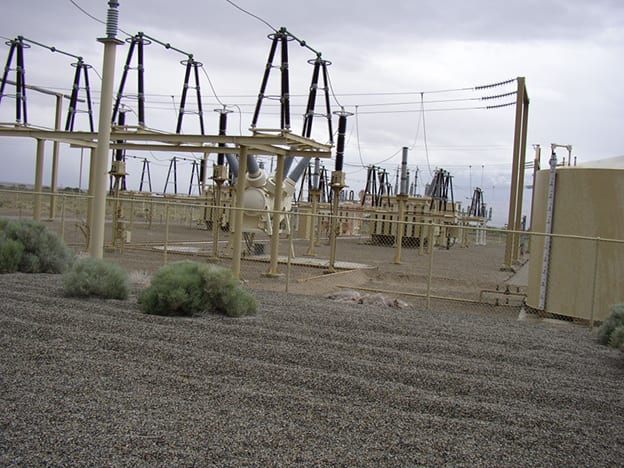 |
| 2. LADWPs Inyo substation. Courtesy: LADWP |
LADWP currently has 900 MW of renewable energy connected to its Barren Ridge Hub, and by 2023, its Eland Solar Farm will add an additional 400 MW of capacity. In addition, the Eland Solar Farm will connect to a lithium battery energy storage system, which will add up to 300 MW of additional capacity.
While LADWP has recently upgraded its transmission capacity on the southern portion of its Inyo-Rinaldi line—from the Barren Ridge Hub to the Rinaldi receiving station—to 2,165 MW, the transmission capacity from north of the Barren Ridge Hub to the Inyo substation remains 450 MW. If the transmission infrastructure from the Barren Ridge Hub to the Inyo substation were upgraded to 1,600 MW, and similar upgrades put into place at the Inyo substation, then, potentially 1,700 MW of renewable energy would be available for export from the Inyo substation during a PSPS event by a neighboring utility.
PG&E’s Helms Pumped Storage Plant lies 50 miles west of LADWP’s Inyo substation, but no transmission connects them (Figure 3). If PG&E were to build a 50-mile transmission line, it could potentially have LADWP’s 1,700 MW of renewable energy delivered during a PSPS event.
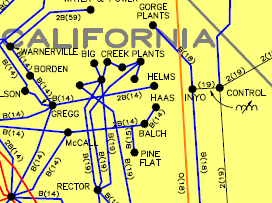 |
| 3. A portion of WECC’s California transmission map is shown here. PG&E’s Helms pumped storage plant is about 50 miles west of LADWP’s Inyo substation. Courtesy: WECC |
During a PSPS event, the variability of renewable energy would make serving PG&E’s affected customers difficult, especially because much of the integrating infrastructure may not be available. However, having that energy delivered to a pumped storage plant, such as the Helms Pumped Storage Plant (Figure 4), could firm and shape the energy for direct delivery to those customers.
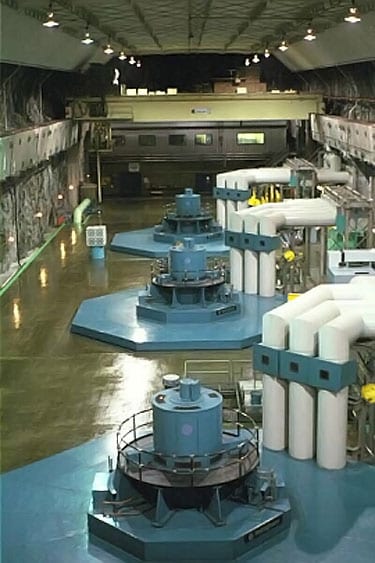 |
| 4. Helms pumped storage facility. Courtesy: California Energy Commission |
While 50 miles is not an insurmountable distance for a transmission line, the terrain between them is most inhospitable (Figure 5). However, the pay-off to PG&E for the construction of the Helms-Inyo transmission line would be a potential method of delivering 1,700 MW to its customers during a PSPS event.
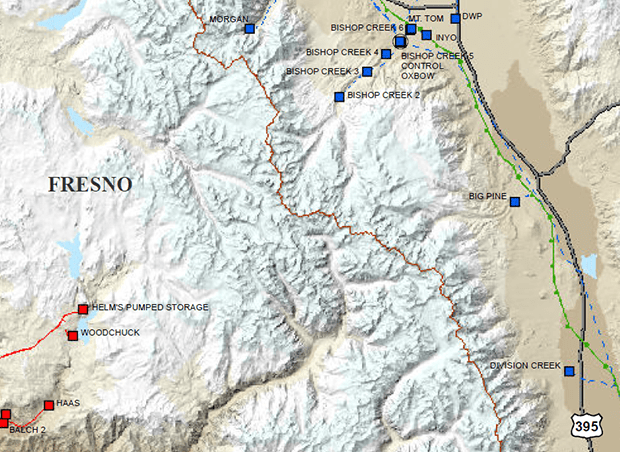 |
| 5. The Sierra Nevada mountain rangelies between Helms pumped storage and Inyo substation. Courtesy: WECC |
The Regulatory Impediment
While a potential arrangement between LADWP and PG&E could be made for the delivery of up to 1,700 MW of renewable energy, this could potentially leave LADWP unable to serve its native load—essentially transferring the outage of millions of customers from PG&E to LADWP. LADWP ratepayers should not be negatively impacted for assisting its neighboring utilities during a time of crisis.
LADWP has coastal generation plants that, up until December 2018, were planned to be repowered. This coastal generation is driven by fossil fuels, and in 2019 a decision was made to disallow the repowering of these plants. If this decision was revisited, LADWP could provide PG&E up to 1,700 MW of renewable generation by providing the differential with these coastal plants. The proposed solution allows LADWP to keep the renewable energy credits of the 1,700 MW of renewable energy in its balancing authority, send 1,700 MW of its renewable energy to PG&E’s Helm Pumped Storage as brown power, and use its coastal plants to generate 1,700 MW of energy to serve its native load. This would enable LADWP to keep serving its customers while assisting PG&E during its PSPS period.
In order for this arrangement to be palatable to LADWP, new regulations would need to be promulgated temporarily exempting any brown generation needed to assist its neighboring utility during a PSPS event. In addition, NOx emissions generated during such an event would need to be exempted or counted against the neighboring utility that is being assisted. This plan would require legislators to weigh the pragmatics of keeping the power on for millions of customers against the idealism of an unobstructed path to 100% renewable generation.
LADWP’s Wildfire Mitigation Efforts
LADWP has a WPP that has been in place since 2008. Effective Jan. 1, 2017, Senate Bill 1028 requires the governing board of each publicly owned utility (POU) to make an initial determination of whether its overhead electric lines and equipment pose a significant risk of catastrophic wildfire based on historical fires and local conditions. On Sept. 5, 2018, LADWP’s board determined that its power system’s overhead electrical lines and equipment do not pose a significant risk of causing a catastrophic wildfire. In fact, LADWP’s service territory primarily resides within an urban city footprint, with the majority of its facilities being outside of high fire hazard areas.
In addition, LADWP has taken substantial steps to reduce wildfire risk through its WPP, which incorporates construction standards, a vegetation management program, and a facility inspection and maintenance program. Furthermore, LADWP does not utilize automatic reclosures on its transmission lines, which greatly reduces the possibility of an LADWP downed power line causing a spark that leads to a wildfire.
This determination means that during a PG&E PSPS event, LADWP will likely be relatively unaffected, and will likely not have to issue its own PSPS warning, potentially making its renewable resources available to assist its neighboring utilities.
Financial Risk Mitigation
LADWP has previously successfully intervened in assisting its neighboring utilities during the California Energy Crisis of 2000. During that time LADWP increased the generation of its in-basin generation units to provide $184 million of energy to investor-owned utilities (IOUs) in California. However, it was more than seven years before LADWP’s account was settled for a markedly lower amount. In addition, during that event, the local regulatory agencies fined LADWP $16 million for exceeding its NOx limitations during this generation increase to support its neighbors.
In lieu of this past experience, it would be prudent to require IOUs seeking potential energy support from neighboring utilities during a PSPS event to secure a letter of credit for $100 million before each wildfire season, which could be transferred immediately to its supporting utility during a PSPS event. This would help ensure that the supporting utility did not incur negative financial impacts as a result of its altruism to the customers of neighboring utilities.
—Robert D. Castro is a lecturer at the University of Southern California.








